Top News

February 11, 2013 Ryukyu Shimpo
On January 30, at Gushikawa Commercial High School the “Gusho Department Store,” a simulated company set up for business training purposes, held its 19th general meeting for shareholders. The management, including its president, Yuya Komesu, announced financial results that reflect revenue growth, and the manager, Takahiro Nakasone, reported on the details of the business, including initiatives such as the development of new suppliers. Members of the new management team were approved and Yume Shimada, a second-grade student, was appointed as the next president.
Net sales for the 2012 fiscal year were 4532535 yen, and net income was 281046 yen. They voted that this year the 200 yen per person dividend, which is normally paid in-kind, would be paid as 8000 yen in cash to each class. It was also approved to donate 50000 yen through UNICEF to the Great East Japan Earthquake emergency fund. A total of 7815 customers came over the two days last fall, and the revenue increased by more than 400000 yen compared with the previous fiscal year.
Nakasone said, “Suppliers turned us down at first. They wanted a written plan, but we went to see them to request their cooperation and in the end were able to purchase the products.” He told his juniors how important the project protocol was, and talked about the difference between email and telephone communication.
School principal Masanori Omine, who is the chairperson of “Gusho Department Store,” encouraged the students, saying, “It was a great success. The management team led the way, and everyone worked very hard.”
Looking back on the training that they did on customer service, Komesu commented, “All the employees who participated worked very hard. The growth in revenue is thanks to people applying everything that they had learned and striving to put customer satisfaction first.” He finished his role as the president this day.
The shareholders of the “Gusho Department Store,” who are all students of the school, each invested 1000 yen when they came into the school. The store opens for two days in the fall.
(English translation by T&CT, Mark Ealey)
Go to Japanese

February 9, 2013 Ryukyu Shimpo
On December 28, 2012, local residents found a postbox that had drifted from Minamisanriku-cho in Miyagi Prefecture to a spot near the mouth of the Yutsun River in Taketomi-cho, in the northeastern area of Iriomote Island. It must have been swept away by the tsunami that came after the Great East Japan Earthquake, on March 11, 2011. Staff of the Okinawa branch of Japan Post collected the postbox on February 4, and will transport it to their Tohoku Branch. They are considering how to use it as a memorial of the tragedy. The sign in Japanese “Seven Utatsu” is still visible, indicating that the postbox was from the 7-Eleven Miyagi Utatsu store, located in the Utatsu district of Minamisanriku. Devastated by the earthquake, the location is now vacant.

On January 4, at the Yaeyama Post Office in Ishigaki, the sign “Seven Utatsu” remains on the postbox.
Traveling in a straight line, the distance between Minamisanriku-cho and Iriomote is about 2400 kilometers. As testimony to its long time at sea, there were shellfish attached to the postbox, and it contained what looks like seaweed, but there were no postal items inside. It is made of fiber-reinforced plastic, and its dimensions are 66 x 45 x 33 centimeters. The postbox would have been knocked off by the tsunami and swept away, but it has still maintained its original shape.
According to Japan Post, 253 postboxes in Miyagi and Fukushima prefectures were swept away by the tsunami. Some have been found in Hokkaido.
Sadakatsu Shimanaka, the assistant manager of the Okinawa Branch that recovered the postbox, said, “I am deeply moved to think that this postbox, which has seen so many letters that people wrote, creating bonds between people, made it all the way to Okinawa.”
(English translation by T&CT, Mark Ealey)
Go to Japanese
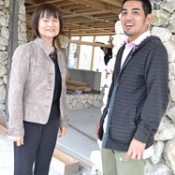
February 15, 2013 Ryukyu Shimpo
Hisako Kato, a Hosei University researcher who has studied Itoman uminchu (fishermen) culture, visited Okinawa to meet Hiroyasu Tamashiro, a local who is to open a fishermen’s style restaurant in Itoman. Tamashiro is from Itoman and is the grandson of an 84 year-old owner of a fish store there, Yoshiko Kinjo, whom Kato introduced in her book published last year. Kato came across an article in the Ryukyu Shimpo reporting that Tamashiro was inspired to open the restaurant by reading her book. This led them to meet.
Kato is from Yokohama and belongs to the Hosei University Institute of Okinawan Studies. Last March she published the book Fishermen of Okinawa – the life and times of Itoman uminchu. In the book, she gave the results of her research, including many interviews carried out over 28 years in fishing towns of Itoman and Yaeyama.
At the start of the book, Kato introduced Yoshiko’s daily life running the fish store with her three friends. Tamashiro said that when he read the book, he felt a connection and that heightened his desire to open the restaurant. When the Ryukyu Shimpo reported this on January 4, Kato read the article and then made contact with Yoshiko after finding her contact details in her research notebook.
Kato was thrilled to be able to meet Yoshiko, who has been in hospital. “The book created connections with people,” said Kato.
Tamashiro will open the Itoman Uminchu Restaurant at Nishizaki, Itoman on February 20. He will offer traditional uminchu dishes such as fish soup arranged to match contemporary culinary styles. Uminchu used to build their houses with coral limestone, so the restaurant is built in similar style.
Kato wishes Tamashiro well, saying, “I am happy that people of the younger generation are striving to continue disappearing traditions.”
Tamashiro said, “I would like to promote fish soup to the extent that many fish soup restaurants appear in Itoman.”
(English translation by T&CT, Lima Tokumori and Mark Ealey)
Go to Japanese
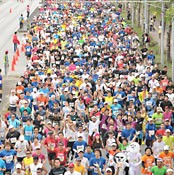
February 18, 2013 Ryukyu Shimpo
On February 17, the 21st Okinawa Marathon was held. The race started at Okinawa Comprehensive Athletic Park in Okinawa City. A total of 14233 participants competed, including 11612 in the full marathon, and 2621 in the ten kilometer road race. The event marked the largest number of entries ever recorded for the Okinawa Marathon. The number of participants who completed the full marathon within the time limit (six hours and 15 minutes) was 8576. As many as 73.85 percent of the contestants finished the race. The ten kilometer road race had 2595 finishers.
Thirty-two year-old Saga resident Tomonori Onizuka, who belongs to the Saga branch of Kyudenko, won the male-division with a time of two hours-23 minutes-58 seconds. Forty-three year-old Tokyo resident Hisako Sasaki won the female-division with a time of three hours-three minutes-35 seconds. Both won the contest for the first time.
The weather was fine at the start of the race with a temperature of 17C and 70 percent humidity. A south-easterly wind blew with a speed of five meters a second. Local residents, employees of local companies and volunteers supported the event by distributing snacks, fruit and water to the runners along the course. The participants smiled as they ran through the city’s main streets.
(English translation by T&CT, Mark Ealey)
Go to Japanese

Go To Video
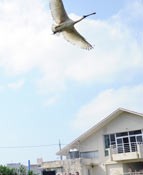
February 15, 2013 Ryukyu Shimpo
On February 14, as its caregivers looked on, the black-faced spoonbill that had been receiving medical treatment in an animal hospital in Naha since the end of last year was safely released back to the wild. Its injuries have healed but the bird was becoming weak because its broken leg had made it unable to catch prey for itself. The spoonbill was looked after by the people at the Manko Waterbird and Wetland Center in Tomigusuku. The bird stepped out of a box at the center and walked around for a short while before taking off and flying up into the blue sky.
The bird was taken into care on December 22, last year. Some experts suggested that the bird was injured when its leg became hooked up in trash. Sakae Shinozaki, a staff member of the Naha Nature Conservation Office of the Ministry of the Environment, said, “We want to use this opportunity to bring to people’s attention the garbage problem that is not only an eyesore, but is also negatively impacting upon wildlife.”
An expert thinks that the bird is a juvenile born last summer. They released it with the identification number tag J16 attached to its leg. “It was fortunate for us to save this bird when we did because it was considerably weakened due to an infection it had in the joint of its foot,” said Junji Takara, a member of the Wildlife Conservation Committee, the Okinawa Veterinary Medical Association and the vet who treated the bird.
(English translation by T&CT, Mark Ealey)
Go to Japanese

Go To Video
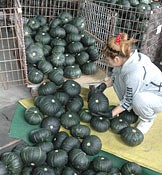
February 7, 2013 Maki Nagamine of Ryukyu Shimpo
Domestic production of pumpkins has started to revive in Okinawa. Since the 1980s, shipping volume of pumpkins from Okinawa decreased after low price pumpkins were imported in increasing quantities, but according to statistics released by JA Okinawa, in 2009 the shipping volume from Okinawa exceeded 1000 tons for the first time in about 20 years. It is estimated to have been 1350 tons in 2012, an increase of 23.7 percent compared with the previous year. There has been a growing production of pumpkins in various parts of Okinawa as the demand for safe food that people can be sure about has been increasing, and as the unit price rises.
Pumpkin has been one of Okinawa’s main agricultural items since the reversion. In 1980, JA shipped out 8278 tons of pumpkins to the main islands of Japan. With the liberalization of farm imports, the annual shipping volume decreased to 4642 tons in 1985, 1670 tons in 1990, 562 tons in 1995, and from that point on stayed at around 500 to 700 tons.
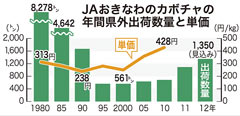
Annual shipping volume of pumpkins and the JA Okinawa unit price.
High demand for domestic produce due to growing concerns about safety of vegetables imported from China since the 2000s has stimulated local production of pumpkins. The unit price of locally produced pumpkins that used to range from 250 to 300 yen per one kilogram, increased to 358 yen in 2005 and 428 yen in 2010.
Hokkaido accounts for the majority of domestic production during the summer season, but during the period from winter to spring, especially from February to April, almost all domestically grown pumpkins are produced in Okinawa. Depending on the seasons, it fetches a price as high as 500 to 600 yen.
According to prefectural government statistics, in 2010 the crop in Okinawa was 3861 tons, which was 2.2 times more than that of 2001, and the harvest area had also expanded to 334 hectares, which was 2.1 times more. In Okinawa Prefecture, Haebaru, Miyako-jima, and Nago are the approved main production areas. The prefectural government supports these locations by setting up exhibitions, but other areas, such as Iriomote Island and Daito Island, are also increasing pumpkin production because the JA has started to promote production. The municipalities on other neighboring islands are also reported to be showing interest in training people to engage in pumpkin farming.
A JA staff member said, “The neighboring islands have larger areas of farm land and so are suitable for pumpkin production. Pumpkins keep well, so they can be shipped to other prefectures using low-cost shipping methods. I would like to encourage farmers in neighboring islands to grow pumpkins, and increase the annual shipment volume to 2000 tons in the course of the next three or four years.”
(English translation by T&CT, Megumi Chibana and Mark Ealey)
Go to Japanese
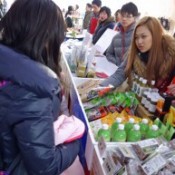
February 11, 2013 Ryota Kotani, Correspondent of the Ryukyu Shimpo
On January 24 and 25, the Kyushu Okinawa Food Fair was held at the Metro City shopping mall in Shanghai. This event was originally scheduled to be held last October, but was postponed due to the dispute between Japan and China over the Senkaku Islands or Diaoyutais.
The Okinawa Prefectural Government exhibited products such as shekwasha (citrus depressa) juice and brown sugar from its antenna shop in Shanghai. Many visitors stopped in front of these novelty items and bought some.
Keisuke Nishihara, a sanshin player who teaches classes in Shanghai, performed his music and songs, creating an exciting atmosphere.
Yukio Sugimoto, the director of the Kumamoto Shanghai Office which managed the food fair, said, “It was a pity we couldn’t hold the event last year due to the Senkaku Island’s issue, but Japan-China relations have improved from the end of the year, so we could hold it. The local police cooperated by patrolling to prevent problems occurring during the fair.” Also, he said that he would like people in Shanghai to know the good things about Kyushu and Okinawa, and hopes that many Chinese people will visit the sites as was the case previously.
The frosty relationship between Japan and China is expected to improve from now through such events.
(English translation by T&CT, Lima Tokumori and Mark Ealey)
Go to Japanese
February 15, 2013 Ryukyu Shimpo
On February 14, the Ministry of the Environment’s Naha Nature Conservation Office announced that in 2012 there were 49 road accidents involving the endangered Yambaru kuina or Okinawa Rail, the highest number since recording began in 1995. For the first time this year, on February 7, an accident involving a Yambaru kuina occurred on Prefectural Road 70 in Sosu in the Kunigami district, resulting in the death of the bird. The Office appeals to drivers to slow down for the sake of these birds.
The number of confirmed accidents has been growing since around 2005. Makoto Fukuda, a nature conservation officer with the Yambaru Wildlife Conservation Center said, “Although we do not know the specific cause of this accident, in most cases the birds have wandered out on the road. Growing numbers appear to be unable to easily escape the path of humans or cars.”
In 45 of 47 accidents the birds were killed, and a month by month analysis of the accidents confirmed the highest number of 13 as having occurred in May. Seven accidents occurred in April, and six in February and June. The office calls for drivers to be on the look out for the Yambaru kuina, saying, “The breeding season of the Yambaru kuina comes to a close before spring, so birds are expected to appear near roads.”
At the same time, the number of the road accidents involving the Ryukyu long-haired rat amounted to nine in 2012, decreasing from 25 in 2011. There have already been two this year.
(English translation by T&CT, Mark Ealey)
Go to Japanese
February 14, 2013 Hideki Matsudo of Ryukyu Shimpo reports from Washington D.C.
On February 8, the White House announced that 90 year-old second-generation Okinawan Terry Shima from Hawaii has received the Presidential Citizens Medal.
During World War II, Shima joined the U.S. Army 442nd Regimental Combat Team, which was made of up of men of Japanese descent and later became a director of the Japanese American Veterans’ Association. The ceremony will be held on February 15 at the White House, and Shima will receive the citation from President Obama.
The Presidential Citizens Medal, the second highest award given by the president, is to honor people who served the country or fellow citizens. This year, Shima and another 18 nominees were selected from among nearly 6000 nominees.
“It is a real honor, and I am very glad to receive the award. It is significant for my comrades who lost their lives during the war in Italy, France and the Pacific,” said Shima.
Shima’s parents were from what was Haneji, now Nago City. In 1944, he joined the 442nd Regimental Combat Team and was deployed to Italy but did not need to participate in combat because the fighting ended the day that he arrived. He went on to serve as an administrative officer on the board of education and as a director of the Japanese American Veterans’ Association.
(English translation by T&CT, Hitomi Shinzato and Mark Ealey)
Go to Japanese
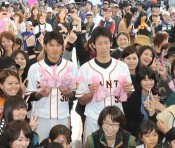
February 15, 2013 Ryukyu Shimpo
On February 14, at Okinawa Cellular Stadium in Naha, the Tokyo Yomiuri Giants, which commenced its second training camp, held a special Valentine’s Day event in the stadium. Two young pitchers, Ryosuke Miyaguni, who is from Okinawa, and Yuki Koyama, gave Valentine’s Day chocolates to female fans who came to support the team.
The Yomiuri Giants held the event two hours earlier than scheduled to fit it in with the training schedule. One hundred female fans, including school children, who were chosen by lottery, waited eagerly for Miyaguni and Koyama to appear.
Eighteen year-old Ayaka Uechi, who said that she is a fan of Miyaguni, came all the way from Miyako-jima for the training camp. She wore a Yomiuri Giants replica jersey bearing Miyaguni’s number. Uechi was thrilled when she was given some chocolate with a card autographed by Miyaguni, and said, “This chocolate is too valuable to eat.”
Miyaguni smiled bashfully as he interacted with the fans. After the event, he gave a glimpse of his shy side, saying, “I was a little nervous because I did not expect so many people to come see us.”
(English translation by T&CT, Mark Ealey)
Go to Japanese
February 8, 2013 Ryukyu Shimpo
Concerned about the effects of air pollution from China, on February 7, the Environmental Preservation Division of the Okinawa Prefectural Government (OPG) released measurements of particles called PM2.5 (that are smaller than 2.5 micrometers) that originate from sources such as car exhaust. This data has been recorded since January 1, 2013, and on their website they state that the daily average values for Okinawa from January 23 to 25 exceeded the national environmental limit of 35 cubic micrometers. Updated estimates during those three days were between 40.9 and 49.6 cubic micrometers.
The OPG began reporting the data in response to increasing numbers of inquiries from citizens about the effect of air pollution from China. As of February 5, the OPG had measurements taken since January 30, but in addition to that data, they then also analyzed the values before January 29, finding that the three days mentioned surpassed the national reference value. Head of the division’s Atmospheric Environment Section, Ken Kinjo, commented that the relationship with air pollution in China is unclear.
On their website, the OPG suggests that people wear masks and avoid going outside when there is smog. They recommend using anti-virus masks because the PM2.5 particles are so small.
The website of the Environmental Preservation Division of the OPG is http://www.pref.okinawa.jp/kankyouhozen/index.html
(English translation by T&CT, Lima Tokumori and Mark Ealey)
Go to Japanese












 Webcam(Kokusai Street)
Webcam(Kokusai Street)


